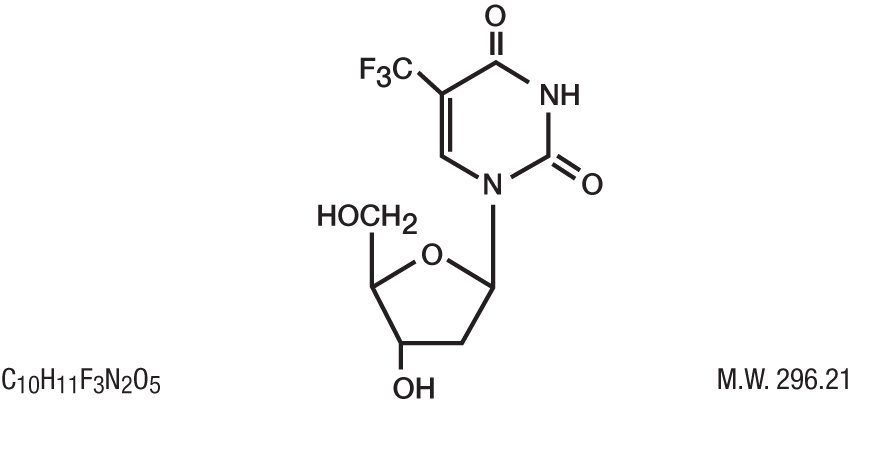Trifluridine
Dosage form: ophthalmic solution
Drug class:Ophthalmic anti-infectives
Medically reviewed by Drugs.com. Last updated on Aug 1, 2021.
On This Page
DESCRIPTION: Trifluridine Ophthalmic Solution (also known as trifluorothymidine, F3TdR, F3T), an antiviral drug for topical treatment of epithelial keratitis caused by herpes simplex virus. The chemical name of Trifluridine is α,α,α-trifluorothymidine. Trifluridine has the following structural formula.
Trifluridine sterile ophthalmic solution contains 1% Trifluridine in an aqueous solution with acetic acid and sodium acetate (buffers), sodium chloride, and thimerosal 0.001% (added as a preservative). The pH range is 5.5 to 6.0 and osmolality is approximately 283 mOsm.
CLINICAL PHARMACOLOGY: Trifluridine is a fluorinated pyrimidine nucleoside with in vitro and in vivo activity against herpes simplex virus, types 1 and 2 and vacciniavirus. Some strains of adenovirus are also inhibited in vitro.
Trifluridine is also effective in the treatment of epithelial keratitis that has not responded clinically to the topical administration of idoxuridine or when ocular toxicity or hypersensitivity to idoxuridine has occurred. In a smaller number of patients found to be resistant to topical vidarabine, Trifluridine was also effective.
Trifluridine interferes with DNA synthesis in cultured mammalian cells. However, its antiviral mechanism of action is not completely known.
In vitro perfusion studies on excised rabbit corneas have shown that Trifluridine penetrates the intact cornea as evidenced by recovery of parental drug and its major metabolite, 5-carboxy-2´-deoxyuridine, on the endothelial side of the cornea. Absence of the corneal epithelium enhances the penetration of Trifluridine approximately two-fold.
Intraocular penetration of Trifluridine occurs after topical instillation of Trifluridine into human eyes. Decreased corneal integrity or stromal or uveal inflammation may enhance the penetration of Trifluridine into the aqueous humor. Unlike the results of ocular penetration of Trifluridine in vitro, 5-carboxy-2´-deoxyuridine was not found in detectable concentrations within the aqueous humor of the human eye.




